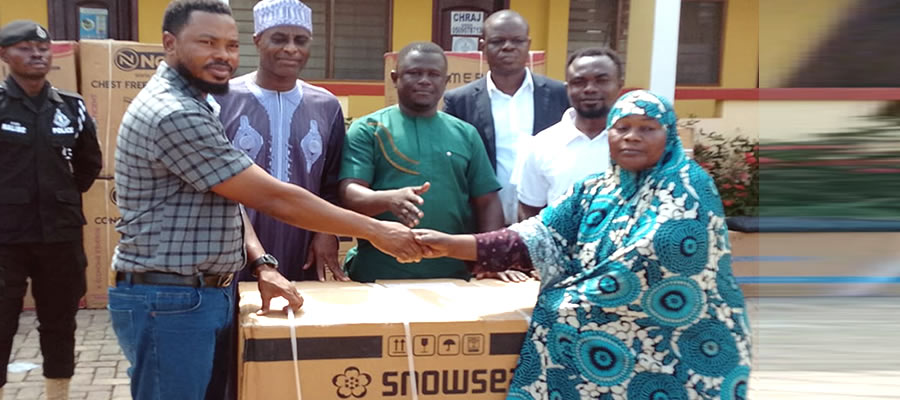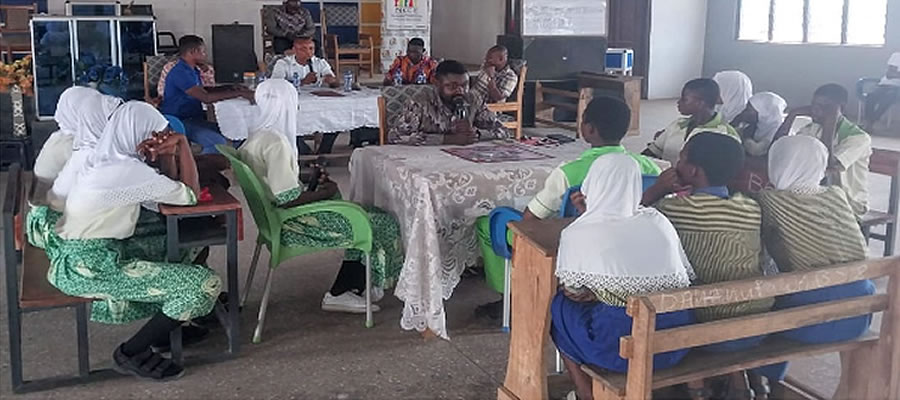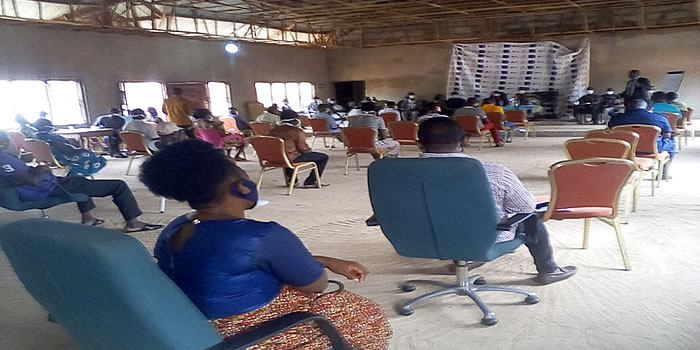

LOCAL ECONOMIC DEVELOPMENT (LED)
LED is one of the strategies that have gained global attention to self and sustainable development. It is seen as a catalyst to empowering the local people to exploit available resources for sustained economic development. Important factors have to do with building the human resource base of the district, undertaking institutional development in the areas of PPPs and business networks for local entrepreneurs, carrying out business development activities by the creation and sustenance of creative industries and promoting locality development through proper zoning, creation of industrial parks and the development of support infrastructure.
There are a number of resources in the District that can be taken up by the District Assembly in conjunction with Private Sector players and other key stakeholders to develop into business clusters, enterprise zones and value chains. These include, yam, cassava, maize, cashew, fish and related products, leather and related products, specialized agricultural produce and value chain ladder development among others. After all local economic development thrives on innovativeness of district management and how well district specialties can be packaged to meet local and global market demand.
THE ECONOMY OF THE DISTRICT
Introduction
The district is noted for supplying in large quantities of yam for the booming Atebubu, Ejura and Kumasi yam markets, cattle and other food crops are also produced in the district. The fish market serves as the main backbone of the Assembly?s revenue. The strategic location (just on the edge of the Volta Lake) makes it ideal for trade in general commodities which are basic to human survival. Vehicles from the southern sector to northern sometimes use the route through to Salaga and to Tamale. Distance from Kumasi to Tamale through Yeji is very short compared to Kintampo to Tamale. However, the poor road network from Mankago through Salaga to Tamale needs to be seriously rehabilitated if the District really wants to fully achieve its potentials. Also the pantoon needs to be replaced or an additional one acquired to facilitate travelling across the Volta Lake.
The service industry over the year has witnessed expansion especially in the areas of trading, telecommunication and retail, shops and bars.
Major Economic Activities
The district has a youth population which is labour active, 71.7 percent are economically active and 28.3 percent economically not active. Out of the economically active population, the employed population constitutes 97.6 percent while the unemployed constitute 2.4 percent in the district.
The proportion of females who did home duties (26.4%) is nearly three times the proportion for males (9.4%), while the percentages of those who are too old or young to work for females (13.0%) is double the rate for males (6.5%). The proportion of males in full time education (76.6%) is higher than the proportion for females (52.8%).
Occupation
Data on the population 15 years and older by the type of occupation and sex shows that, majority of the population is into agriculture, due to the fertile nature of farmlands in the district. A total of 65.9 percent of the employed population are skilled agricultural forestry and fishery workers. The next most important venture in the district is that of crafts and trade works which employs 14.1 percent of the population. The district also has 11.7 percent of its population engaged as service and sales worker. The least sector of employment in the district is clerical support jobs and managerial jobs.
With respect to the sexes, there are more males (77.2%) engaged in agricultural forestry and fisheries in the district than females (54.4%). There are more females (21.2%) in craft and related trades work than males (7.0%), however there are equal proportions of males and females working as managers (0.9%).
From the figure, it is evident that agriculture is the mainstay of the local economy, which employs more than half of the economically active population (labour force). Nearly every household in the District is engaged in farming or an agricultural related activity. Farming in the district is largely carried out on manual and small scale basis with economic intentions. The average cultivated land ranges between 4 – 6 acres for all crops.
Despite its importance in the district economy, much of the agricultural potentials in the district remain unutilized. For instance, out of the total of 14,469 hectares of arable land only 2,058 hectares is currently utilized. The district?s irrigation potentials also remain unexploited. Nothing concrete has been done to develop irrigation potentials that have been discovered in about six (6) localities. The soils in the area favor the production of a variety of crops. Crops currently grown in commercial quantities include Yam, Cassava, maize and Rice. Major production centres include the Prang Abease corridor and Adjaraja Beposo,.
Manufacturing Industries The district has quite a number of people in the manufacturing industry (11.5%) of which 4.0 percent are males and 19.1 percent are females. Wholesale and retail; repair of motor vehicles and motorcycles is the third largest industry employing 11.4 percent. This is probably because the district has a vibrant market from which out-board motors for powering boats and canoes as well as motor vehicles and motor cycles for transporting of goods and materials to and from in the district are sold. The sector employs 5,726 people and is mostly dominated by females who constitute 17.1 percent with only 5.8 percent of them being males
Energy
The major sources of energy for lighting in the communities in the District are Electricity (38.5%), Kerosene (27.1%), Flashlight/Torch light (33%) and Firewood (0.5%), Candles are however not in use. That for looking on the other hand includes firewood (64.8%), charcoal (31%) with other sources recording minimal figures in energy for cooking. Table 1.7 below illustrates the various sources of energy.
Table 16: Energy for Lighting and Cooking
Source: Ghana Statistical Service, 2010
Oil and Gas
Pru West is one of the 32 identified districts for the potential onshore oil and gas exploration and development along the voltaian basin by SEA carried out by the Environmental Protection Agency. GNPC and relevant stakeholders have started gathering seismic data and information along the basin for further analysis. This has the potential of opening up the district to both local and foreign migrants. The district will be confronted with several development challenges that will affect communities and livelihood positively and negatively.
Management in view of this has to take proactive measures to ensure that existing natural resources are not jeopardized in the quest to exploit the oil and gas. Adequate compensations, capacity building and sensitization ought to be seriously considered among the local people in order to reduce its impact.
Financial Institutions
The Pru West District can boast of only one commercial bank (GN Bank), one rural banks (Yapra Rural Banks). All these financial institutions are concentrated only at the major communities like Prang, Abease and Zabrama.
Access to credit facilities from the few financial institutions in the district, for small-scale, agroprocessors, farmers and enterprises are limited and unreliable due to demand for high collateral, and loan recovery problems if granted. Most of the activities of the SME?s and other agricultural activities are therefore funded from personal loans, relatives and money lenders whose interest rates tend to be very high.
The Assembly should therefore create a platform for dialogue between the financial sector and the SME?s under the private sector drive of the government to encourage lending to the SMEs and agro-based industries.
Cooperatives
The major cooperatives in the district include Dinpa Cashew Farming and Marketing, Nkanbon Ye cooperative, Dadea So Aba cooperative,Nyame Akwan, Nyame Adom , Apesika Mango Farmers? cooperative etc. According to farmers who were part of various cooperatives, some of the benefits they enjoy are easy access to loans as well as social support in times of marriages and funerals. Farmers who were not members of any cooperative complain of its non-existence in their respective communities while others complain of lack of unity and trustworthiness among farmers. It can be inferred that most farmers (89.6%) do not have easy access to credit facilities and this affects their level outputs.
DISTRICT ASSEMBLY FINANCE
This section analyses revenue and expenditure of the Assembly, however, because the Assembly was inaugurated less than a year, there is no adequate information on expenditure and other materials.
Revenue sources
There are two main sources of revenue namely internal and external sources. Internal revenues are those collected by the Assembly using its own existing collection machinery. These consist of rates, lands, (excluding stool lands), fees and fines, licenses, rents, investments and miscellaneous. External sources are mostly grants from central government, including DACF, Royalties, DDF and external agencies like development partners and NGOs. The district is constrained in given trends of revenue and expenditure as indicated above.
Considering the erratic flow of the DACF and its associated restrictions regarding disbursement, both endogenous and exogenous revenue sources need to be vigorously mobilized. Advantage must be taken of the Public-Private Partnership policy of the government to explore the possibility of active private participation in revenue collection eg; property rate, as well as the development and management of facilities like market stores, public toilets, guest houses and water systems. Develop the local economy by taking advantage of Rural Enterprise Programme being implemented by the BAC. Favorable conditions need to be created eg setting up of a Public-Private Partnership / NGO Desk to attract and facilitate NGO and private sector support to the Assembly. Existing links must also be strengthened with the Assembly?s development partners to expand their operations through proposal writing
Expenditure
The expenditure of the Assembly is divided into recurrent and capital expenditure. The main expenditure items under the recurrent are personal emoluments, Travelling and Transport, general expenditure, Maintenance, repairs and renewals and Miscellaneous.
Capital expenditure consists of all expenditure made on development projects and programmes. In anticipation of an increased development expenditures considering the deprive nature of the district, adequate internal revenues need to be generated as counterpart funding. Part of the internally generated revenue needs to be applied to development projects, to justify its continued payment by the people. We are unable to provide statistics on expenditure because the district is not up to a year old.
Date Created : 7/12/2023 12:00:00 AM










 facebook
facebook
 twitter
twitter
 Youtube
Youtube
 +233 593 831 280
+233 593 831 280 0800 430 430
0800 430 430 GPS: GE-231-4383
GPS: GE-231-4383 info@ghanadistricts.com
info@ghanadistricts.com Box GP1044, Accra, Ghana
Box GP1044, Accra, Ghana